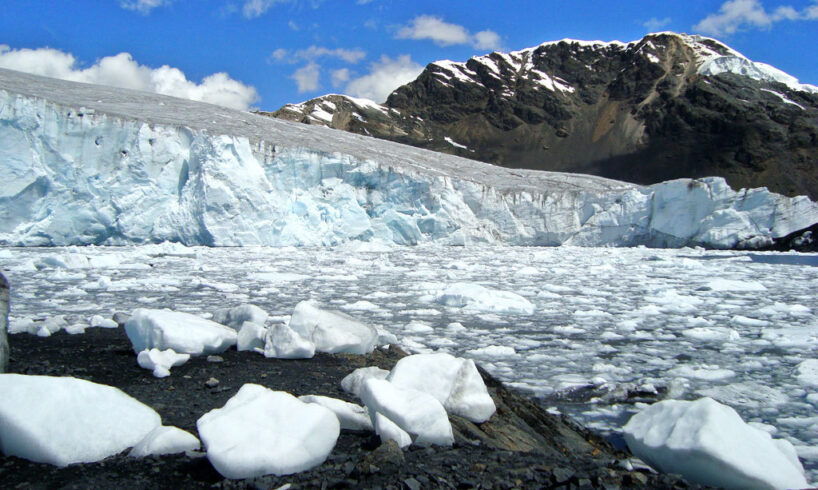
I’ve always been a sucker for glacier lingo, whimsical words for a harsh landscape gouged, smoothed and bulldozed by ice. Moulins, drumlins, eskers and moraines. Cirques and arêtes. Cold katabatic winds blowing down a mountain, huffed from a glacier’s snout and said to be its spirit.
Jemma Wadham’s Ice Rivers: A Story of Glaciers, Wilderness, and Humanity leans into this duality of whimsy and harshness, cheerfully pulling readers into this strange, icy world. Wadham, a glaciologist at the University of Bristol in England, confesses that her goal is to give readers a sense of connection to glaciers, which she knowingly anthropomorphizes: In her writing, glaciers have heavy bodies, dirty snouts and veins filled with water.
“When I’m with them, I feel like I’m among friends,” she writes. “It is, in many ways, a love story.” And knowing the glaciers, she reasons — perhaps coming to love them — is key to trying to save them.
Accordingly, the book’s chapters are anchored by site, and each chapter documents a different field expedition or series of expeditions to a particular glacier. Wadham takes us from the Swiss Alps to Norway’s Svalbard islands, from India’s Himalayas to Antarctica’s McMurdo Dry Valleys. It’s a breezy read, with an eager party host vibe (“let me introduce to you my friend the glacier; I think you two will get along”).
While describing each site, Wadham dives into an engaging mishmash of personal recollections about her fieldwork, snippets of accessible glacier and climate science (I now know that these rivers of ice have three different manners of flow), a dash of alpine and polar exploration history, and many bits of local color. Ötzi the 5,300-year-old iceman, Erik the Red, Svalbard’s many polar bears and wild Patagonian horses all make an appearance, not to mention the mummified corpses of seals and penguins littering the Dry Valleys.
An interesting thread winding through the book concerns how the focus of glaciology as a field has shifted through time. After several years of not winning grants that would allow her to continue working on Svalbard, in 2008 Wadham got the opportunity to go to Greenland instead. “Valley glaciers were no longer considered quite as cutting-edge to the research council funders,” she writes. “Instead, glaciologists had become obsessed with the vast ice sheets,” for the potential of their meltwaters to raise sea levels and alter ocean currents. Several years later, funders began to call for projects looking at melting glaciers’ impacts on ocean life and the water cycle, opening up an opportunity for Wadham to study Patagonia’s fast-changing glacial region.
Where the book really comes alive is in its vivid snapshots of a scientist’s life in the field: making a bleary-eyed cup of coffee in Patagonia using a thin sock as a filter; fearfully skittering across fragile fjord ice on a Ski-Doo; consuming tins of bland fiskeboller, or fish balls, which were mostly used for food but sometimes for rifle practice; solo dancing away a gray mood on a pebbly beach on Svalbard, with a rifle ready to repel polar bears resting nearby on the stones.
These recollections are honest, funny and poignant, and reveal how the highs and lows of fieldwork are inextricably intertwined. Wadham writes, for example, of dreading the “hollow feeling caused by constant sleep deprivation” due to the midnight sun and the relentless roaring of winds and water, a feeling tempered by her fierce love for the open expanses of the wild and for pursuing a “big mission.”
She also writes wistfully of the “communal mirth of field-camp life” where she had never laughed as much before and, less wistfully, of the heavy, claustrophobic atmosphere of an Antarctic research station with its supercharged heating system and extreme politeness over meals with strangers. Against the backdrop of Patagonia’s swiftly shrinking glaciers, Wadham comes to grips with difficult personal losses, even as she wrestles with mysterious headaches. Months later, while recovering from emergency brain surgery, she secretly begins to write about her glaciers. Still more months pass before she finds her way back to the ice, this time in the Peruvian Andes.
“I quickly realized one key thing about fieldwork — if you think you are there to work, you’re gravely mistaken,” Wadham writes. “You’re actually there to survive, and perform some research along the way — if you’re lucky.… In some ways I found all this ‘surviving’ a grounding process.”
Every glacier Wadham has studied has shrunk since she first set foot on the ice over a quarter century ago. But Ice Rivers isn’t focused on mourning those glaciers so much as on celebrating the peace and purpose — the grounding line — Wadham found in them. It certainly makes me want to know them better.
This article was originally posted on ‘Ice Rivers’ invites you to get to know our world’s melting glaciers